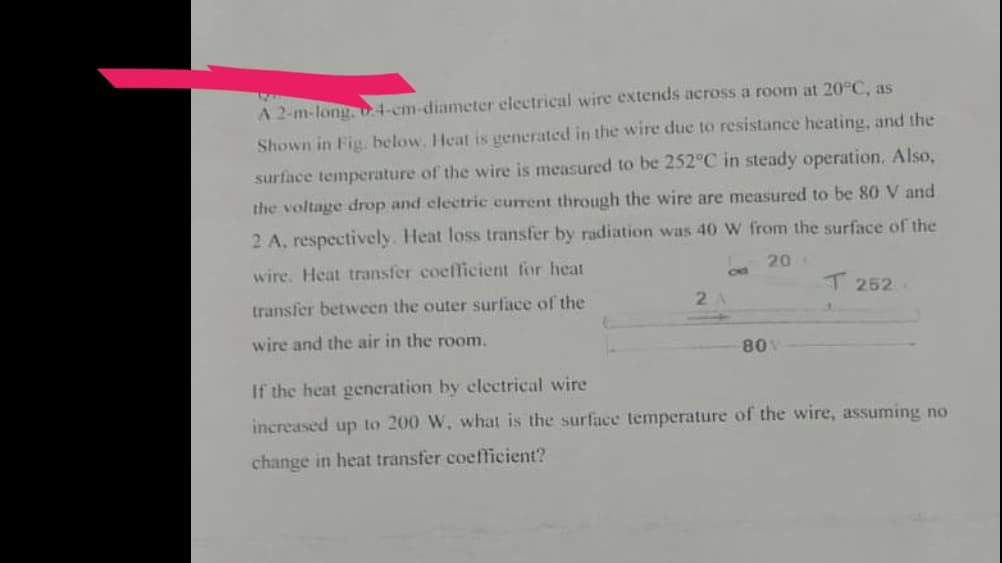A 2-m-long, 4-cm-diameter electrical wire extends across a room at 20°C, as Shown in Fig. below. Heat is generated in the wire due to resistance heating, and the surface temperature of the wire is measured to be 252°C in steady operation. Also, the voltage drop and electric current through the wire are measured to be 80 V and 2 A, respectively. Heat loss transfer by radiation was 40 W from the surface of the 20 wire. Heat transfer coefficient for heat transfer between the outer surface of the wire and the air in the room. 2 A 80 V T 252 If the heat generation by electrical wire increased up to 200 W, what is the surface temperature of the wire, assuming no change in heat transfer coefficient?
A 2-m-long, 4-cm-diameter electrical wire extends across a room at 20°C, as Shown in Fig. below. Heat is generated in the wire due to resistance heating, and the surface temperature of the wire is measured to be 252°C in steady operation. Also, the voltage drop and electric current through the wire are measured to be 80 V and 2 A, respectively. Heat loss transfer by radiation was 40 W from the surface of the 20 wire. Heat transfer coefficient for heat transfer between the outer surface of the wire and the air in the room. 2 A 80 V T 252 If the heat generation by electrical wire increased up to 200 W, what is the surface temperature of the wire, assuming no change in heat transfer coefficient?
Principles of Heat Transfer (Activate Learning with these NEW titles from Engineering!)
8th Edition
ISBN:9781305387102
Author:Kreith, Frank; Manglik, Raj M.
Publisher:Kreith, Frank; Manglik, Raj M.
Chapter1: Basic Modes Of Heat Transfer
Section: Chapter Questions
Problem 1.19P: 1.19 A cryogenic fluid is stored in a 0.3-m-diameter spherical container is still air. If the...
Related questions
Question

Transcribed Image Text:A 2-m-long, 4-cm-diameter electrical wire extends across a room at 20°C, as
Shown in Fig. below. Heat is generated in the wire due to resistance heating, and the
surface temperature of the wire is measured to be 252°C in steady operation. Also,
the voltage drop and electric current through the wire are measured to be 80 V and
2 A, respectively. Heat loss transfer by radiation was 40 W from the surface of the
wire. Heat transfer coefficient for heat
20 C
transfer between the outer surface of the
wire and the air in the room.
2
80 V
T 252
If the heat generation by electrical wire
increased up to 200 W, what is the surface temperature of the wire, assuming no
change
heat transfer coefficient?
Expert Solution
This question has been solved!
Explore an expertly crafted, step-by-step solution for a thorough understanding of key concepts.
Step by step
Solved in 4 steps with 14 images

Knowledge Booster
Learn more about
Need a deep-dive on the concept behind this application? Look no further. Learn more about this topic, mechanical-engineering and related others by exploring similar questions and additional content below.Recommended textbooks for you

Principles of Heat Transfer (Activate Learning wi…
Mechanical Engineering
ISBN:
9781305387102
Author:
Kreith, Frank; Manglik, Raj M.
Publisher:
Cengage Learning

Principles of Heat Transfer (Activate Learning wi…
Mechanical Engineering
ISBN:
9781305387102
Author:
Kreith, Frank; Manglik, Raj M.
Publisher:
Cengage Learning